Correlation Analysis of Compounds in Essential Oil of Amomum tsaoko Seed and Fruit Morphological Characteristics, Geographical Conditions, Locality of Growth
Abstract
1. Introduction
2. Materials and Methods
2.1. Plant Materials
2.2. Chemicals
2.3. Measurements of Morphological Characteristics
2.4. Sample Preparation for GC-MS (SIM)
2.5. GC-MS Analysis
2.6. Compound Identification and Quantification
2.7. Statistical Analysis
3. Results and Discussion
3.1. Morphological Characteristics
3.2. Compound Identification and Quantification
3.3. Correlation between Compounds and Morphological Characteristics, Geographical Conditions
3.4. Correlation between Compounds and Locality of Growth
4. Conclusions
Supplementary Materials
Author Contributions
Funding
Institutional Review Board Statement
Informed Consent Statement
Data Availability Statement
Acknowledgments
Conflicts of Interest
References
- de Boer, H.; Newman, M.; Poulsen, A.D.; Droop, A.J.; Fér, T.; Hiên, L.T.T.; Hlavatá, K.; Lamxay, V.; Richardson, J.E.; Steffen, K.; et al. Convergent morphology in Alpinieae (Zingiberaceae): Recircumscribing Amomum as a monophyletic genus. Taxon 2018, 67, 6–36. [Google Scholar] [CrossRef]
- Wu, D.L.; Kai, L. Flora of China; Science Press: Beijing, China, 2000; Volume 24, pp. 347–356. [Google Scholar]
- Kim, J.G.; Jang, H.; Le, T.P.L.; Hong, H.R.; Lee, M.K.; Hong, J.T.; Lee, D.; Hwang, B.Y. Pyranoflavanones and Pyranochalcones from the Fruits of Amomum tsaoko. J. Nat. Prod. 2019, 82, 1886–1892. [Google Scholar] [CrossRef]
- Yang, Y.W.; Liu, X.L.; Pu, C.X.; Qian, Z.G.; Guan, K.Y. The Influence of Altitude and Latitude on Breeding of Amomum tsaoko (Zingiberaceae). J. Biosci. Med. 2014, 2, 9–17. [Google Scholar] [CrossRef]
- Chinese Pharmacopoeia Commission. Pharmacopoeia of the People’s Republic of China; China Medical Science and Technology Press: Beijing, China, 2015; Volume IV, pp. 203–204. [Google Scholar]
- Chen, C.; You, F.; Wu, F.; Luo, Y.; Zheng, G.; Xu, H.; Liu, Y. Antiangiogenesis Efficacy of Ethanol Extract from Amomum tsaoko in Ovarian Cancer through Inducing ER Stress to Suppress p-STAT3/NF-kB/IL-6 and VEGF Loop. Evid. Based Complement Altern. Med. 2020, 2020, 2390125. [Google Scholar] [CrossRef] [PubMed]
- Lee, S.; Lee, J.C.; Subedi, L.; Cho, K.H.; Kim, S.Y.; Park, H.-J.; Kim, K.H. Bioactive compounds from the seeds of Amomum tsaoko Crevost et Lemaire, a Chinese spice as inhibitors of sphingosine kinases, SPHK1/2. RSC Adv. 2019, 9, 33957–33968. [Google Scholar] [CrossRef]
- Cui, Q.; Wang, L.T.; Liu, J.Z.; Wang, H.M.; Guo, N.; Gu, C.B.; Fu, Y.J. Rapid extraction of Amomum tsaoko essential oil and determination of its chemical composition, antioxidant and antimicrobial activities. J. Chromatogr. B Anal. Technol. Biomed. Life Sci. 2017, 1061, 364–371. [Google Scholar] [CrossRef]
- Yang, Y.; Yan, R.W.; Cai, X.Q.; Zheng, Z.L.; Zou, G.L. Chemical composition and antimicrobial activity of the essential oil of Amomum tsaoko. J. Sci. Food Agric. 2008, 88, 2111–2116. [Google Scholar] [CrossRef]
- Wang, Y.; You, C.X.; Wang, C.F.; Yang, K.; Chen, R.; Zhang, W.J.; Du, S.S.; Geng, Z.F.; Deng, Z.W. Chemical Constituents and Insecticidal Activities of the Essential Oil from Amomum tsaoko against Two Stored-Product Insects. J. Oleo Sci. 2014, 63, 1019–1026. [Google Scholar] [CrossRef]
- Guo, N.; Zang, Y.P.; Cui, Q.; Gai, Q.Y.; Jiao, J.; Wang, W.; Zu, Y.G.; Fu, Y.J. The preservative potential of Amomum tsaoko essential oil against E. coil, its antibacterial property and mode of action. Food Control. 2017, 75, 236–245. [Google Scholar] [CrossRef]
- Zhang, T.T.; Lu, C.L.; Jiang, J.G. Bioactivity evaluation of ingredients identified from the fruits of Amomum tsaoko Crevost et Lemaire, a Chinese spice. Food Funct. 2014, 5, 1747–1754. [Google Scholar] [CrossRef]
- Liu, G.; Jin, M.; Cai, C.; Ma, C.; Chen, Z.; Gao, L. Soil Microbial Community Structure and Physicochemical Properties in Amomum tsaoko-based Agroforestry Systems in the Gaoligong Mountains, Southwest China. Sustainability 2019, 11, 546. [Google Scholar] [CrossRef]
- Ma, M.L.; Lei, E.; Meng, H.L.; Wang, T.T.; Xie, L.Y.; Shen, D.; Zhou, X.W.; Lu, B.Y. Cluster and principal component analysis based on SSR markers of Amomum tsaoko in Jinping County of Yunnan Province. AIP Conf. Proc. 2017, 1864, 020070. [Google Scholar] [CrossRef]
- Zhang, W.; Lu, B.Y.; Meng, H.L.; Wei, X.; Yang, Z.Q.; Yang, S.C. Phenotypic diversity analysis of the fruit of Amomum tsaoko Crevost et Lemarie, an important medicinal plant in Yunnan, China. Genet. Resour. Crop Evol. 2019, 66, 1145–1154. [Google Scholar] [CrossRef]
- Kharbach, M.; Marmouzi, I.; El Jemli, M.; Bouklouze, A.; Vander Heyden, Y. Recent advances in untargeted and targeted approaches applied in herbal-extracts and essential-oils fingerprinting—A review. J. Pharm. Biomed. Anal. 2020, 177, 112849. [Google Scholar] [CrossRef]
- Shen, X.T.; Gong, X.Y.; Cai, Y.P.; Guo, Y.; Tu, J.; Li, H.; Zhang, T.; Wang, J.L.; Xue, F.Z.; Zhu, Z.J. Normalization and integration of large-scale metabolomics data using support vector regression. Metabolomics 2016, 12, 89. [Google Scholar] [CrossRef]
- Wei, T.Y.; Simko, V. R Package “Corrplot”: Visualization of a Correlation Matrix (Version 0.84). 2017. Available online: https://github.com/taiyun/corrplot (accessed on 20 July 2020).
- Shannon, P.; Markiel, A.; Ozier, O.; Baliga, N.S.; Wang, J.T.; Ramage, D.; Amin, N.; Schwikowski, B.; Trey, I. Cytoscape: A software environment for integrated models of biomolecular interaction networks. Genome Res. 2003, 13, 2498–2504. [Google Scholar] [CrossRef]
- Díaz-Gutiérrez, C.; Trillos, Á.T.; Villa, V.; Silva, Z.; Acevedo, L.; Arroyave, C.; Poschenrieder, C.; Peláez, C. Altitude and fertilization type: Concentration of nutrients and production of biomass in Stevia rebaudiana Bertoni. J. Plant Nutr. 2020, 44, 322–336. [Google Scholar] [CrossRef]
- Chen, D.D.; Li, Q.; Liu, Z.; He, F.; Chen, X.; Xu, S.; Zhao, X.; Zhao, L. Variations of Forage Yield and Nutrients with Altitude Gradients and Their Influencing Factors in Alpine Meadow of Sanjiangyuan, China. J. Soil Sci. Plant Nutr. 2020, 20, 2164–2174. [Google Scholar] [CrossRef]
- Tan, Q.; Wang, G. Decoupling of nutrient element cycles in soil and plants across an altitude gradient. Sci. Rep. 2016, 6, 34875. [Google Scholar] [CrossRef]
- Starkenmann, C.; Mayenzet, F.; Brauchli, R.; Wunsche, L.; Vial, C. Structure elucidation of a pungent compound in black cardamom: Amomum tsaoko Crevost et Lemarie (Zingiberaceae). J. Agric. Food Chem. 2007, 55, 10902–10907. [Google Scholar] [CrossRef]
- Sim, S.; Tan, S.K.; Kohlenberg, B.; Braun, N.A. Amomum tsaoko—Chinese Black Cardamom: Detailed Oil Composition and Comparison with two other cardamom species. Nat. Prod. Commun. 2019, 14, 1934578X1985767. [Google Scholar] [CrossRef]
- Ahn, S.Y.; Choi, H.S. Compositional Changes in Cassia mimosoides var. noname (M.) Essential Oil. J. Essent. Oil Bear. Plants 2009, 12, 509–520. [Google Scholar] [CrossRef]
- Ghasemi Pirbalouti, A.; Mahdad, E.; Craker, L. Effects of drying methods on qualitative and quantitative properties of essential oil of two basil landraces. Food Chem. 2013, 141, 2440–2449. [Google Scholar] [CrossRef]
- Tohidi, B.; Rahimmalek, M.; Arzani, A. Essential oil composition, total phenolic, flavonoid contents, and antioxidant activity of Thymus species collected from different regions of Iran. Food Chem. 2017, 220, 153–161. [Google Scholar] [CrossRef]
- He, X.C.; Wang, S.Y.; Shi, J.Y.; Sun, Z.L.; Lei, Z.T.; Yin, Z.L.; Qian, Z.G.; Tang, H.R.; Xie, H. Genotypic and Environmental Effects on the Volatile Chemotype of Valeriana jatamansi Jones. Front. Plant. 2018, 10, 1003. [Google Scholar] [CrossRef] [PubMed]
- Gupta, M.; Rout, P.K.; Misra, L.N.; Gupta, P.; Singh, N.; Darokar, M.P.; Saikia, D.; Singh, S.C.; Bhakuni, R.S. Chemical composition and bioactivity of Boswellia serrata Roxb. essential oil in relation to geographical variation. Plant Biosyst. Int. J. Deal. All Asp. Plant Biol. 2017, 151, 623–629. [Google Scholar] [CrossRef]
- Chen, S.L.; Zhang, L.P.; Cai, X.M.; Li, X.; Bian, L.; Luo, Z.X.; Li, Z.Q.; Chen, Z.M.; Xin, Z.J. (E)-Nerolidol is a volatile signal that induces defenses against insects and pathogens in tea plants. Hortic. Res. 2020, 7, 52. [Google Scholar] [CrossRef] [PubMed]
- Quintana-Rodriguez, E.; Rivera-Macias, L.E.; Adame-Alvarez, R.M.; Torres, J.M.; Heil, M. Shared weapons in fungus-fungus and fungus-plant interactions? Volatile organic compounds of plant or fungal origin exert direct antifungal activity in vitro. Fungal Ecol. 2018, 33, 115–121. [Google Scholar] [CrossRef]
- Wu, Z.Y.; Zhu, Y.C. Yunnan Vegetation; Science Press: Beijing, China, 1987; pp. 31–32. [Google Scholar]


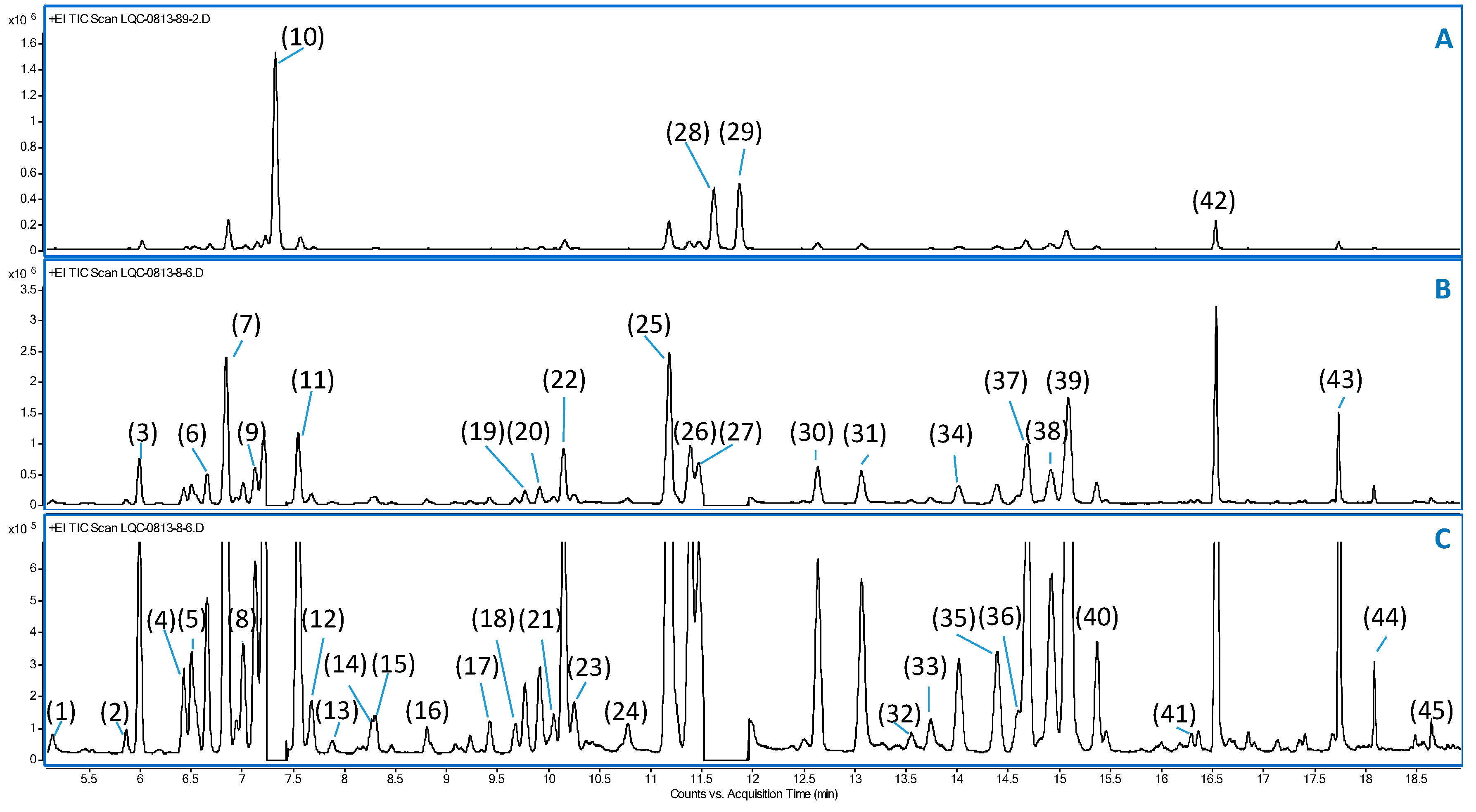

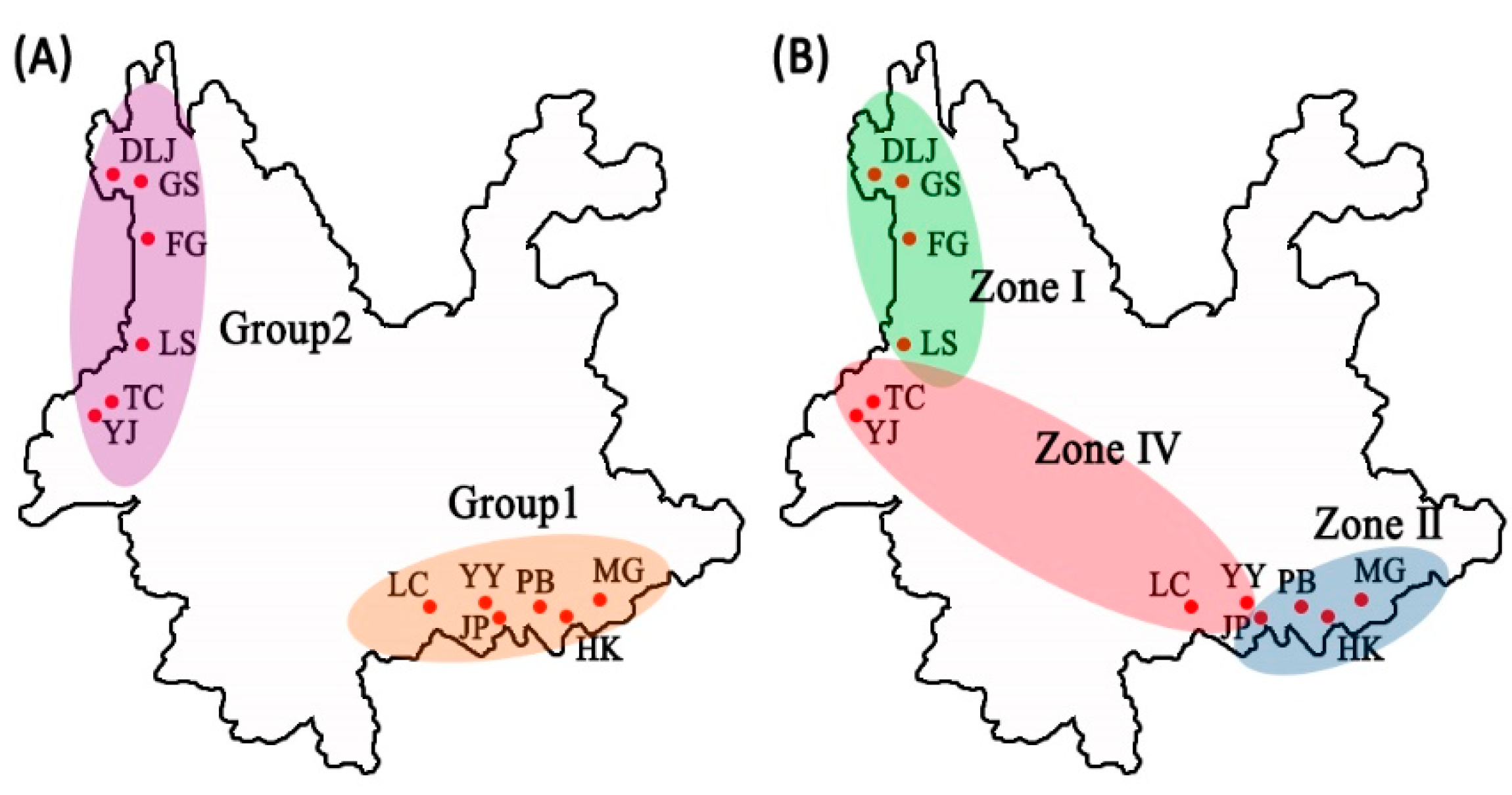
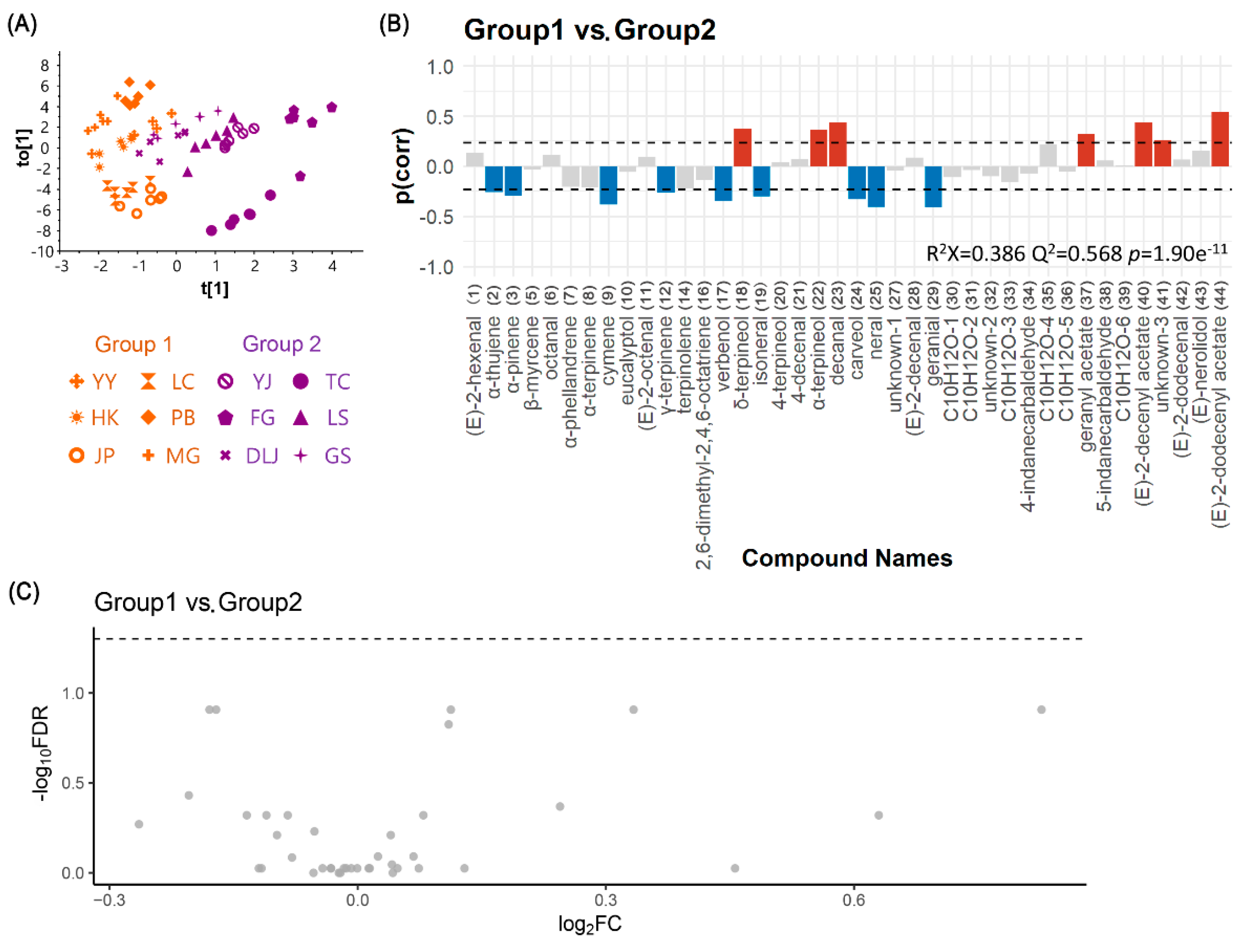
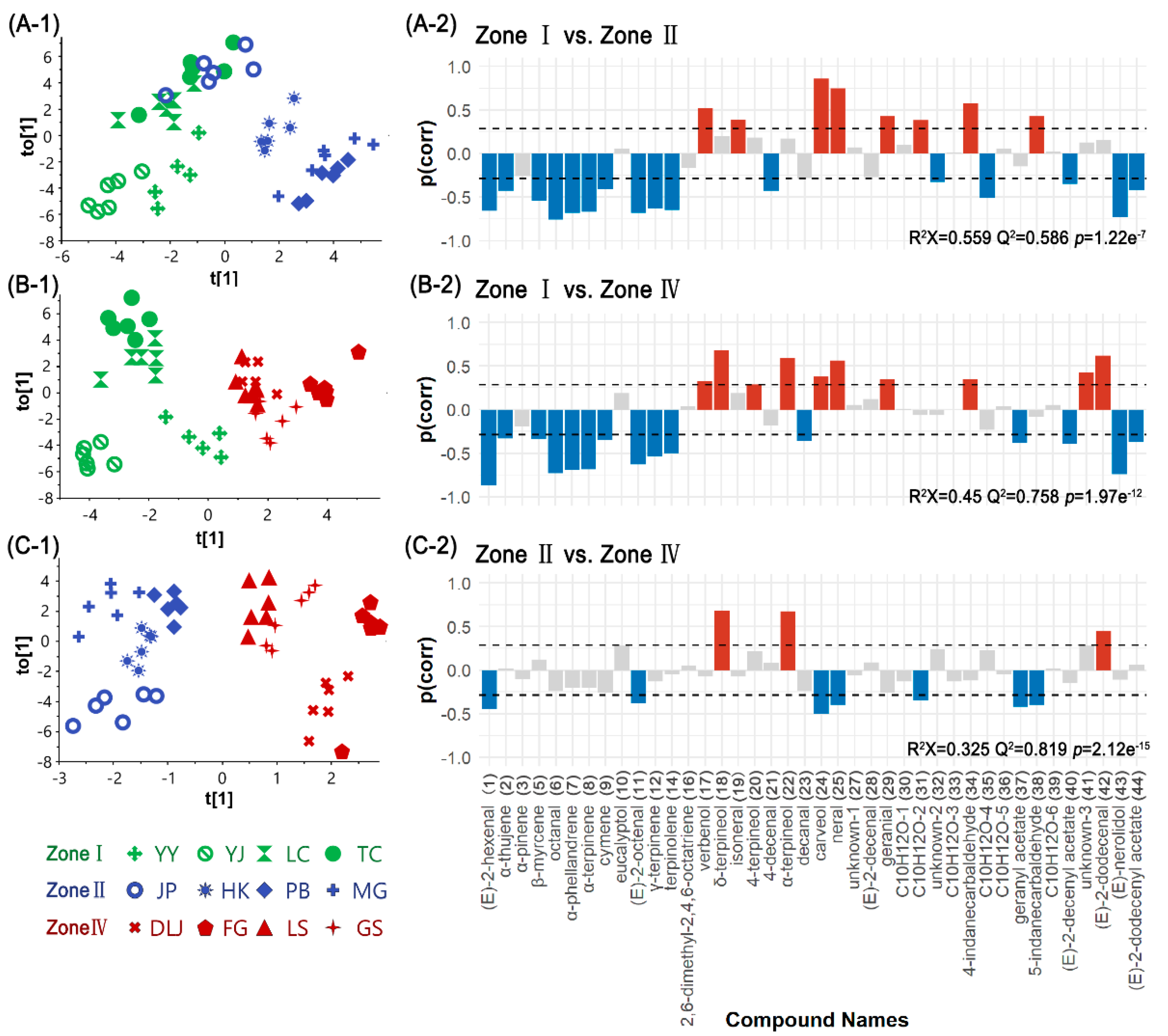
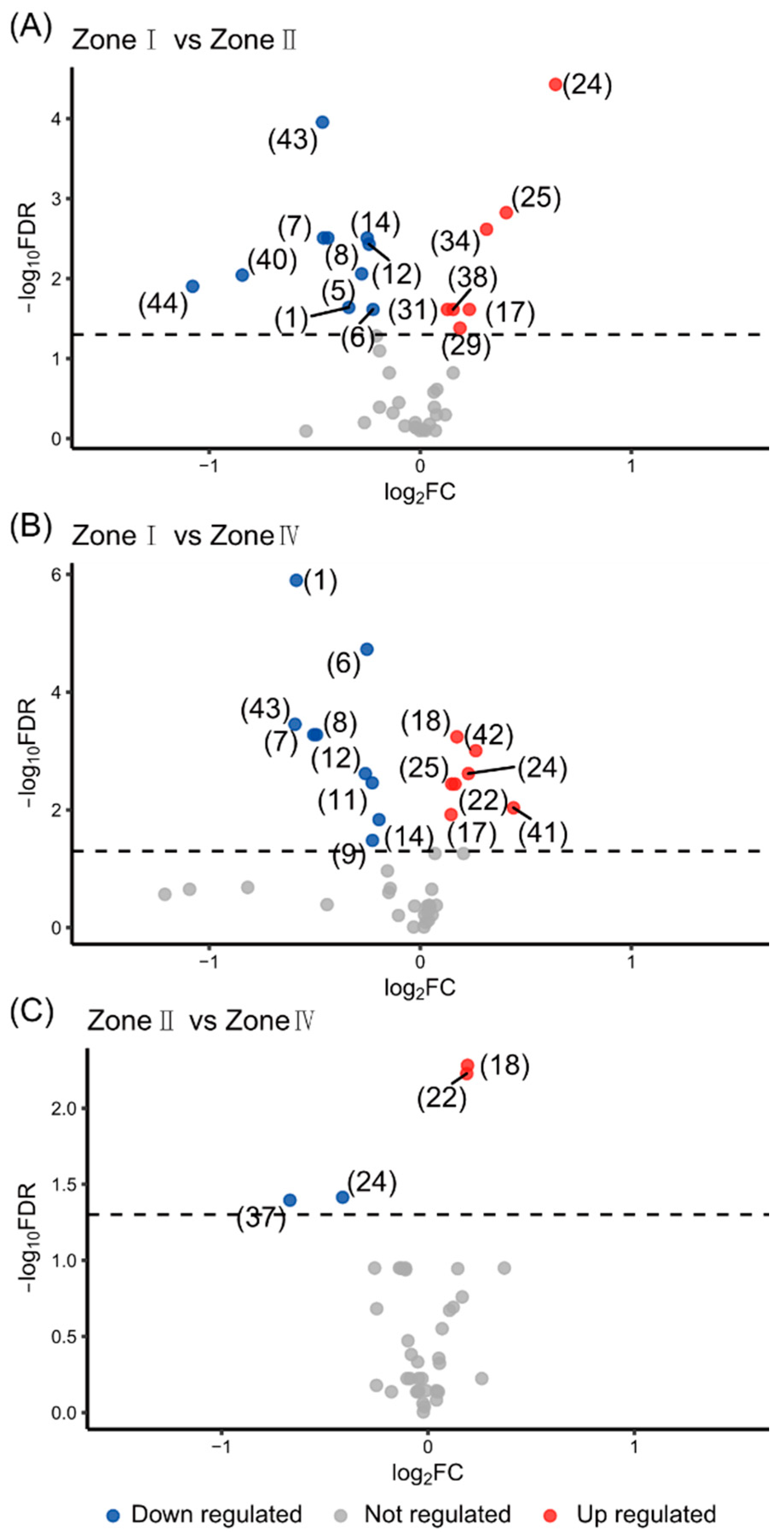
| Region | Abbr. | Longitude (° N) | Latitude (° E) | Altitude (m) | Mean Annual Temperature (°C) | Mean Annual Precipitation (mm) | Date of Harvest | Collector | Voucher |
|---|---|---|---|---|---|---|---|---|---|
| Yuanyang | YY | 103.0233 | 23.0070 | 1651.6 | 24.4 | 1189.1 | 30 October 2018 | Guodong Li | ZMCG0017 |
| Lvchun | LC | 102.4303 | 22.9989 | 1648.5 | 16.6 | 2415.2 | 31 October 2018 | Congwei Yang | ZMCG0018 |
| Yingjiang | YJ | 98.2131 | 24.9506 | 1985.4 | 19.3 | 1464.0 | 31 October 2018 | Guodong Li | ZMCG0019 |
| Tengchong | TC | 98.3933 | 25.0761 | 1483.9 | 16.5 | 1531.0 | 31 October 2018 | Yaowen Yang | ZMCG0020 |
| Hekou | HK | 104.1225 | 22.8742 | 900.0 | 23.0 | 2022.7 | 5 September 2018 | Guodong Li | ZMCG0015 |
| Pingbian | PB | 103.6924 | 22.9915 | 1325.5 | 16.5 | 1650.0 | 5 September 2018 | Guodong Li | ZMCG0014 |
| Jinping | JP | 103.2293 | 22.7852 | 1243.1 | 18.0 | 2330.0 | 29 October 2018 | Guodong Li | ZMCG0016 |
| Maguan | MG | 104.3972 | 23.0086 | 1320.0 | 16.9 | 1345.0 | 4 September 2018 | Guodong Li | ZMCG0013 |
| Fugong | FG | 98.8692 | 27.0289 | 1218.2 | 16.9 | 1443.3 | 7 November 2018 | Guodong Li | ZMCG0024 |
| Lushui | LS | 98.8527 | 25.8540 | 822.0 | 21.2 | 747.6 | 2 November 2018 | Guodong Li | ZMCG0021 |
| Gongshan | GS | 98.6722 | 27.7497 | 1502.3 | 16.0 | 3700.0 | 7 November 2018 | Guodong Li | ZMCG0023 |
| Dulongjiang | DLJ | 98.3492 | 27.8950 | 1486.5 | 15.0 | 3900.0 | 7 November 2018 | Guodong Li | ZMCG0022 |
| Region | Abbr. | Length * | Width * | Length/Width * | Fresh Weight * | Dry Weight * | Dehydration Rate * | Seed Number/Fruit * | 1000 Seeds Weight # | Oil Yield of Seeds & | |||||||||
|---|---|---|---|---|---|---|---|---|---|---|---|---|---|---|---|---|---|---|---|
| cm | RSD % | cm | RSD % | RSD % | g | RSD % | g | RSD % | % | RSD % | Count | RSD % | g | RSD % | % | RSD % | |||
| Yuanyang | YY | 3.73 | 16.09 | 3.13 | 8.63 | 1.20 | 15.93 | 19.79 | 25.77 | 5.15 | 23.88 | 73.92 | 1.65 | 44.17 | 32.33 | 77.31 | 1.05 | 3.91 | 2.05 |
| Lvchun | LC | 3.50 | 12.86 | 2.70 | 10.37 | 1.30 | 8.80 | 13.85 | 28.23 | 3.29 | 29.48 | 76.26 | 1.47 | 33.77 | 36.84 | 66.94 | 3.97 | 3.85 | 2.34 |
| Yingjiang | YJ | 3.51 | 12.25 | 2.70 | 12.59 | 1.31 | 13.18 | 14.10 | 31.70 | 3.24 | 32.72 | 77.19 | 2.22 | 32.03 | 37.46 | 70.86 | 1.07 | 3.48 | 1.44 |
| Tengchong | TC | 3.36 | 17.86 | 2.57 | 9.73 | 1.31 | 17.14 | 12.51 | 29.98 | 3.01 | 32.56 | 76.16 | 2.67 | 30.93 | 35.31 | 66.30 | 2.35 | 4.08 | 1.23 |
| Hekou | HK | 3.36 | 14.29 | 2.60 | 13.46 | 1.30 | 13.64 | 12.26 | 30.91 | 2.91 | 37.46 | 76.70 | 5.40 | 39.53 | 30.53 | 58.33 | 0.86 | 3.99 | 3.01 |
| Pingbian | PB | 3.29 | 14.59 | 2.64 | 9.85 | 1.26 | 15.75 | 12.82 | 25.82 | 2.74 | 28.47 | 78.65 | 2.99 | 32.90 | 32.46 | 59.56 | 0.99 | 4.03 | 1.74 |
| Jinping | JP | 3.51 | 16.81 | 2.67 | 10.11 | 1.32 | 13.47 | 12.94 | 30.14 | 3.07 | 31.60 | 76.42 | 2.42 | 30.13 | 43.84 | 66.01 | 1.58 | 4.17 | 3.36 |
| Maguan | MG | 3.44 | 14.53 | 2.71 | 11.44 | 1.27 | 11.79 | 13.70 | 28.39 | 3.17 | 36.28 | 77.12 | 5.47 | 37.30 | 45.47 | 55.97 | 1.84 | 2.93 | 4.81 |
| Fugong | FG | 3.31 | 15.41 | 2.49 | 12.05 | 1.34 | 15.67 | 12.24 | 31.78 | 3.09 | 35.60 | 75.07 | 2.64 | 29.67 | 40.14 | 66.53 | 1.01 | 3.46 | 1.45 |
| Lushui | LS | 3.35 | 14.93 | 2.47 | 12.55 | 1.38 | 20.13 | 11.12 | 26.89 | 2.81 | 31.67 | 75.09 | 2.14 | 30.77 | 37.18 | 64.17 | 2.23 | 3.54 | 1.41 |
| Gongshan | GS | 3.29 | 15.81 | 2.64 | 11.36 | 1.26 | 17.58 | 12.52 | 28.27 | 3.09 | 34.95 | 75.80 | 2.99 | 30.33 | 36.30 | 72.01 | 2.93 | 3.14 | 3.50 |
| Dulongjiang | DLJ | 3.36 | 13.10 | 2.51 | 11.55 | 1.35 | 12.60 | 11.95 | 29.21 | 3.28 | 29.27 | 72.58 | 1.57 | 35.60 | 31.18 | 65.23 | 2.54 | 3.67 | 2.18 |
| Average | 3.42 | 14.88 | 2.65 | 11.14 | 1.30 | 14.64 | 13.32 | 28.92 | 3.24 | 31.99 | 75.91 | 2.80 | 33.93 | 36.59 | 65.77 | 1.87 | 3.69 | 2.37 | |
| No. | RT | Actual RI | Reference RI | Actual RI- Reference RI | Name |
|---|---|---|---|---|---|
| 1 | 5.14 | 849 | 853 | −4 | (E)-2-hexenal |
| 2 | 5.86 | 925 | 926 | −1 | α-thujene |
| 3 | 5.99 | 933 | 935 | −2 | α-pinene |
| 4 | 6.42 | 970 | 968 | 2 | sabinene |
| 5 | 6.50 | 985 | 983 | 2 | β-myrcene |
| 6 | 6.65 | 999 | 1003 | −4 | octanal |
| 7 | 6.84 | 1007 | 1003 | 4 | α-phellandrene |
| 8 | 7.01 | 1023 | 1015 | 8 | α-terpinene |
| 9 | 7.12 | 1034 | 1026 | 8 | cymene |
| 10 | 7.35 | 1046 | 1032 | 14 | eucalyptol |
| 11 | 7.55 | 1068 | 1072 | −4 | (E)-2-octenal |
| 12 | 7.68 | 1071 | 1054 | 17 | γ-terpinene |
| 13 | 7.88 | 1079 | 1072 | 7 | trans-sabinenehydrate |
| 14 | 8.26 | 1095 | 1088 | 7 | terpinolene |
| 15 | 8.31 | 1101 | 1097 | 4 | linalool |
| 16 | 8.80 | 1130 | 1131 | −1 | 2,6-dimethyl-2,4,6-octatriene |
| 17 | 9.42 | 1166 | 1133 | 33 | verbenol |
| 18 | 9.67 | 1173 | 1166 | 7 | δ-terpineol |
| 19 | 9.77 | 1179 | 1165 | 14 | isoneral |
| 20 | 9.91 | 1184 | 1178 | 6 | 4-terpineol |
| 21 | 10.05 | 1196 | 1194 | 2 | 4-decenal |
| 22 | 10.15 | 1197 | 1189 | 8 | α-terpineol |
| 23 | 10.25 | 1207 | 1202 | 5 | decanal |
| 24 | 10.77 | 1230 | unknown-1 | ||
| 25 | 11.18 | 1244 | 1246 | −2 | neral |
| 26 | 11.39 | 1256 | 1259 | −3 | geraniol |
| 27 | 11.46 | 1259 | unknown-2 | ||
| 28 | 11.63 | 1265 | 1265 | 0 | (E)-2-decenal |
| 29 | 11.87 | 1275 | 1269 | 6 | geranial |
| 30 * | 12.63 | 1315 | C10H12O-1 | ||
| 31 * | 13.06 | 1325 | C10H12O-2 | ||
| 32 | 13.55 | 1343 | unknown-3 | ||
| 33 * | 13.74 | 1348 | C10H12O-3 | ||
| 34 | 14.02 | 1356 | 1307 | 49 | 4-indanecarbaldehyde |
| 35 * | 14.39 | 1366 | C10H12O-4 | ||
| 36 * | 14.59 | 1370 | C10H12O-5 | ||
| 37 | 14.68 | 1384 | 1387 | −3 | geranyl acetate |
| 38 * | 14.92 | 1388 | 5-indanecarbaldehyde | ||
| 39 * | 15.09 | 1393 | C10H12O-6 | ||
| 40 | 15.37 | 1407 | 1406 | 1 | (E)-2-decenyl acetate |
| 41 | 16.36 | 1452 | unknown-4 | ||
| 42 | 16.54 | 1467 | 1482 | −15 | (E)-2-dodecenal |
| 43 | 17.74 | 1575 | 1559 | 16 | (E)-nerolidol |
| 44 | 18.09 | 1608 | 1609 | −1 | (E)-2-dodecenyl acetate |
| 45 | 18.65 | 1676 | 1673 | 3 | (E)-2-tetradecenal |
| No. | Name | Zone I vs. Zone II | Zone I vs. Zone IV | Zone II vs. Zone IV |
|---|---|---|---|---|
| 1 | (E)-2-hexenal | − | − | |
| 5 | β-myrcene | − | ||
| 6 | octanal | − | − | |
| 7 | α-phellandrene | − | − | |
| 8 | α-terpinene | − | − | |
| 9 | cymene | − | ||
| 11 | (E)-2-octenal | − | ||
| 12 | γ-terpinene | − | − | |
| 14 | terpinolene | − | − | |
| 17 | verbenol | + | + | |
| 18 | δ-terpineol | + | + | |
| 22 | α-terpineol | + | + | |
| 24 | unknown-1 | + | + | − |
| 25 | neral | + | + | |
| 29 | geranial | + | ||
| 31 | C10H12O-2 | + | ||
| 34 | 4-indanecarbaldehyde | + | ||
| 37 | geranyl acetate | − | ||
| 38 | 5-indanecarbaldehyde | + | ||
| 40 | (E)-2-decenyl acetate | − | ||
| 41 | unknown-4 | + | ||
| 42 | (E)-2-dodecenal | + | ||
| 43 | (E)-nerolidol | − | − | |
| 44 | (E)-2-dodecenyl acetate | − |
Publisher’s Note: MDPI stays neutral with regard to jurisdictional claims in published maps and institutional affiliations. |
© 2021 by the authors. Licensee MDPI, Basel, Switzerland. This article is an open access article distributed under the terms and conditions of the Creative Commons Attribution (CC BY) license (https://creativecommons.org/licenses/by/4.0/).
Share and Cite
Li, G.; Lu, Q.; Wang, J.; Hu, Q.; Liu, P.; Yang, Y.; Li, Y.; Tang, H.; Xie, H. Correlation Analysis of Compounds in Essential Oil of Amomum tsaoko Seed and Fruit Morphological Characteristics, Geographical Conditions, Locality of Growth. Agronomy 2021, 11, 744. https://doi.org/10.3390/agronomy11040744
Li G, Lu Q, Wang J, Hu Q, Liu P, Yang Y, Li Y, Tang H, Xie H. Correlation Analysis of Compounds in Essential Oil of Amomum tsaoko Seed and Fruit Morphological Characteristics, Geographical Conditions, Locality of Growth. Agronomy. 2021; 11(4):744. https://doi.org/10.3390/agronomy11040744
Chicago/Turabian StyleLi, Guodong, Qinwei Lu, Jingjian Wang, Qingyu Hu, Pinghui Liu, Yaowen Yang, Yongkun Li, Huiru Tang, and Hui Xie. 2021. "Correlation Analysis of Compounds in Essential Oil of Amomum tsaoko Seed and Fruit Morphological Characteristics, Geographical Conditions, Locality of Growth" Agronomy 11, no. 4: 744. https://doi.org/10.3390/agronomy11040744
APA StyleLi, G., Lu, Q., Wang, J., Hu, Q., Liu, P., Yang, Y., Li, Y., Tang, H., & Xie, H. (2021). Correlation Analysis of Compounds in Essential Oil of Amomum tsaoko Seed and Fruit Morphological Characteristics, Geographical Conditions, Locality of Growth. Agronomy, 11(4), 744. https://doi.org/10.3390/agronomy11040744







